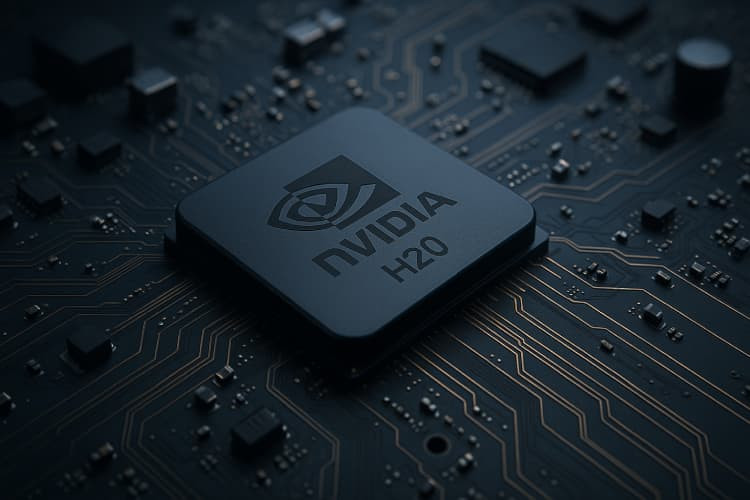Nvidia H20 Chip Faces China Backlash Over Security Fears
Insights | 19-08-2025 | By Robin Mitchell

Key Things to Know:
- China accuses Nvidia’s H20 chip of hardware “backdoors”, citing potential risks to national security and digital sovereignty.
- The H20 was designed for the Chinese market in response to US export restrictions on advanced AI processors introduced in 2023.
- Beijing’s cyberspace watchdog summoned Nvidia over concerns that the chip could bypass authentication or include hidden shutdown mechanisms.
- State media's warnings reflect a wider strategy to reduce reliance on Western semiconductors and boost China's domestic tech sector.
In recent years, geopolitical tensions between the United States and China have shifted from quiet undercurrents to open strategic rivalry. Trade disputes, technology restrictions, and cyber accusations have all contributed to a complex and often volatile relationship. Now, a new battleground has emerged in the form of hardware security—specifically, artificial intelligence chips and the potential risks they may carry.
What triggered China’s latest concerns, what role does Nvidia’s H20 chip play in this evolving tech war, and what are the broader implications for global supply chains and technological sovereignty?
The Shaky Ground Between the US and China
Over the past decade, the US–China relationship has been in a slow, grinding decline, similar to two tectonic plates under constant pressure. Every so often, the friction breaks into open conflict, and the aftershocks ripple through global industries.
China has faced repeated accusations from the US and its allies: industrial espionage, intellectual property theft, disregard for international trade rules, and direct cyberattacks against governments and private corporations. None of these charges are particularly new, but the frequency, and public bluntness, with which they’re made has increased.
From Accusation to Containment Strategy
On the other side of the equation, the US has escalated its efforts to constrain China’s industrial and technological ambitions. Washington has made it clear that it views China as not just an economic competitor, but a potential existential threat to the international order it helped build. “Cooperation” has been replaced with “containment,” especially in sectors seen as strategically critical.
The semiconductor industry is a prime example of the fallout. The US has placed increasingly strict export bans on advanced chips, fabrication equipment, and design tools destined for China. The logic is simple; if China can’t access the building blocks of modern computing, it can’t develop next-generation military or surveillance technologies at the same pace.
And the immediate impact was painful for China. Certain industries slowed, production schedules slipped, and entire technology roadmaps had to be rewritten. But the bans also lit a fire under Beijing’s push for technological self-sufficiency. In some areas, that gamble has paid off, and much quicker than many in the West expected.
Beijing’s Bet on Open-Source Pays Off
A large part of China’s comeback has been driven by open-source hardware and software, most notably the RISC-V instruction set architecture. With no licensing fees, no Western chokepoints, and a rapidly growing global developer base, RISC-V has become the foundation for a new generation of Chinese-designed processors. It’s not total independence yet, but the gap is narrowing.
This has created a new dilemma. In sectors where Chinese companies are still allowed to buy Western components, critics in the US and Europe are asking whether that access should continue. The argument is simple: why supply a strategic rival with the very tools it needs to reduce its dependency, and possibly turn the tables? After all, in geopolitics, the rug can be pulled at a moment’s notice.
Chinese State Media Flags Security Concerns Over Nvidia H20 Chips
Recently, Chinese state media have publicly raised concerns over the safety and quality of Nvidia’s H20 artificial intelligence chips, claiming the processors may contain hardware “backdoors” capable of remote shutdown. The allegations, published Sunday by Yuyuan Tantian, a social media account affiliated with state broadcaster CCTV, follow weeks of scrutiny from Beijing’s cyberspace watchdog.
According to Reuters, the Yuyuan Tantian WeChat post suggested that the H20 was “neither technologically advanced nor environmentally friendly,” further stating that Chinese consumers “have the option not to buy it.” The language used was unusually direct for a state-linked platform, indicating a broader strategic pivot to reinforce domestic technological autonomy while publicly discrediting Western-made AI accelerators.
The H20 was developed as a lower-spec AI accelerator specifically for the Chinese market after the US introduced export restrictions on advanced Nvidia chips in late 2023. While the administration of US President Donald Trump banned sales outright in April this year, the ban was reversed in July.
Export Reversals Fuel Strategic Doubt
This rapid reversal of export policy has left a vacuum of certainty. Industry observers suggest the abrupt policy flip-flop may have contributed to scepticism within China, where hardware that was once deemed too advanced to export is now being marketed as safe for open sale. In high-stakes geopolitical contexts, such shifts are often interpreted less as commercial adjustments and more as signals of deeper intent.
On July 31, Chinese regulators summoned Nvidia to address potential security risks in the H20. Authorities specifically questioned whether the chip allowed hidden methods to bypass authentication or security controls. Nvidia denied the allegations at the time and reiterated that its products contain no such backdoors.
Scrutiny Deepens Over Foreign-Made Chips
Despite Nvidia’s denials, the regulatory inquiry underscores a growing mistrust in foreign-made hardware. With state media now openly framing the H20 as a risk, the burden of proof appears to have shifted—placing the onus on Western firms to validate security claims through transparent technical disclosures, independent audits, or partnerships with vetted Chinese institutions.
Echoing the broader scepticism, Yuyuan Tantian described the H20 as “neither environmentally friendly, nor advanced, nor safe,” suggesting that Chinese consumers could simply choose not to buy it. This stance aligns with an earlier People’s Daily commentary, which urged Nvidia to provide “convincing security proofs” before it could regain user trust in China.
The broader context of this mistrust lies in the expanding remit of China’s cybersecurity law, which allows authorities to review foreign-supplied tech for potential “national security threats.” In this environment, even unsubstantiated claims—especially when amplified by party-affiliated media—can serve as de facto policy signals aimed at reshaping domestic procurement decisions and global semiconductor strategy.
Could There Be Truth in China’s Claims?
The idea of hardware containing a remote kill switch isn’t science fiction. Such capabilities have been theorised, demonstrated, and, in some cases, confirmed in both consumer and military-grade electronics. The notion that the H20, a chip designed specifically for the Chinese market after US export restrictions, could have some form of built-in remote control or hidden access mechanism isn’t a wild conspiracy theory. In the current geopolitical climate, it’s not even that far-fetched.
It’s also worth remembering that China has been accused of similar tactics. Investigations in the past have claimed that Chinese-supplied hardware, including server racks, contained additional chips not in the original design, components allegedly inserted during manufacturing to provide hidden access or data exfiltration capabilities.
Whether or not Nvidia’s H20 chips actually contain such features almost doesn’t matter. Beijing’s public accusation sends a strategic message: China intends to tighten its national defence posture by removing dependencies on Western technology, especially anything that could be leveraged as a control point.
And frankly, this isn’t surprising. I’ve been saying for years, push China far enough, and it will move toward complete technological self-sufficiency. The result? Any leverage the West once had through supply chain dominance evaporates, and the geopolitical chessboard changes permanently.

